Botu: they eat anacondas, piranhas and turn pink from scars (14 photos)
Previously, Amazonian dolphins were considered werewolves that take the form of a handsome young man. At night, they emerged from the water to seduce local beauties and take them to the underwater kingdom. And during the day, they turned into a beast whose skin turned pink from the kisses of hundreds of girls and the rays of the setting sun. Alas, science gives much more cruel and prosaic explanations. 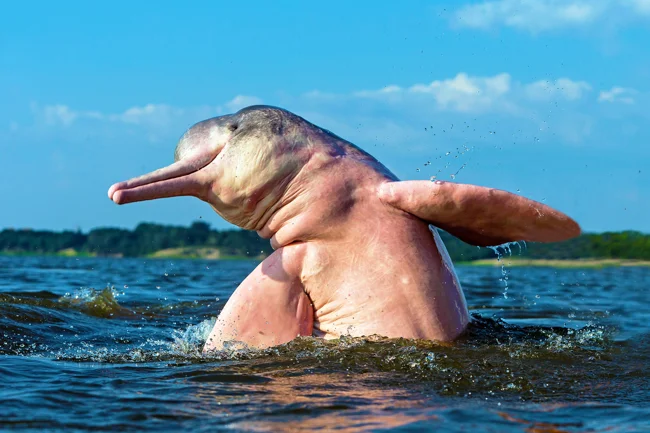
Beauties, your prince has arrived.
Pink skin is a chronicle of fierce battles, woven from hundreds of scars. Dolphins don't communicate with sweet words. They prefer to write messages... right to your face.
The Amazon dolphin, or inia, or botu, is the largest representative of river cetaceans. Long ago, it separated from the classic dolphins, spat on the ocean and chose to be happy. A smart move! In open waters, there are a lot of enemies: you have to compete with killer whales and beware of sharks. In freshwater bodies, the inia has become the leading predator of the system, despite the fact that its size for a cetacean is extremely average. Their maximum: 2 meters in length and under 200 kilograms in weight. 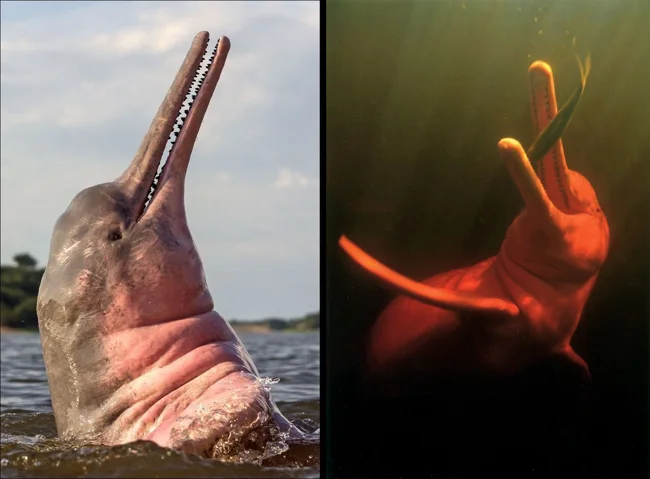
Anyone can become prettier. The main thing is to choose the right light and angle!
At first glance, it seems that a carefree life has turned the inia into a skuf. The heavy body resembles something like a sausage. The sloping back has turned into a full-fledged hump. And the tiny eyes are almost invisible behind the plump cheeks. Yes, with her current physique, the inia will not be able to do somersaults on the waves. But the Amazon dolphin does not need it. Life in the rivers dictates its own rules, to which the entire body had to be remade! 
That same cookie-fish that drowned in tea.
For example, the botu can turn its head. This ability does not seem extraordinary to us, but for cetaceans this is plasticity at the level of rhythmic gymnastics. Because sea dolphins have fused cervical vertebrae, while river dolphins do not. The wide, long flippers of the inia are not suitable for high-speed swimming, but they are great for dexterous maneuvers in shallow water and swampy mangrove thickets. The eyes of the botu, although small, are the most sighted of all cetaceans. They are protected from the sun and distinguish light and shadow perfectly. 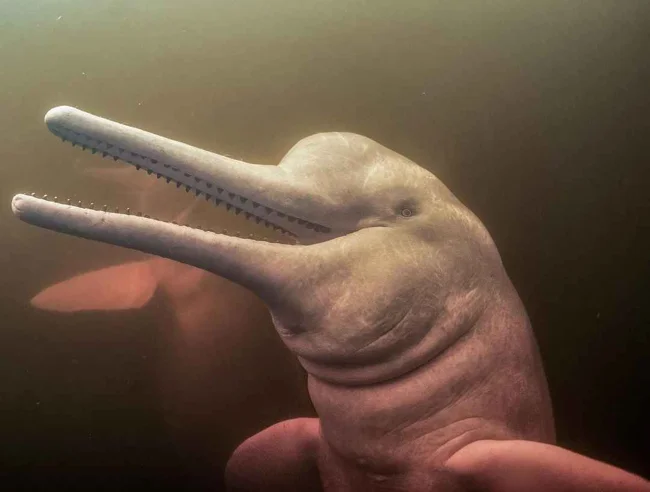
Welcome to the Amazon, baby! Why are you shaking?
However, under water, river dolphins, compared to their sea counterparts, are "short-sighted". To navigate in space, inii, like other cetaceans, use echolocation - they click on ultrasound, and then listen to the echo of their clicks. Sound waves are reflected differently from different objects, which gives the animals an idea of the world around them. So, the river dolphin clicks quieter than the sea dolphin. That is, he sees the terrain in front of him, but has trouble distinguishing details in the distance. And this is not a bug, but a feature! The Amazon is a muddy river. Rocks, rapids, currents, snags - all this is confusing. So you need to look "under your feet" and not scan everything at once. 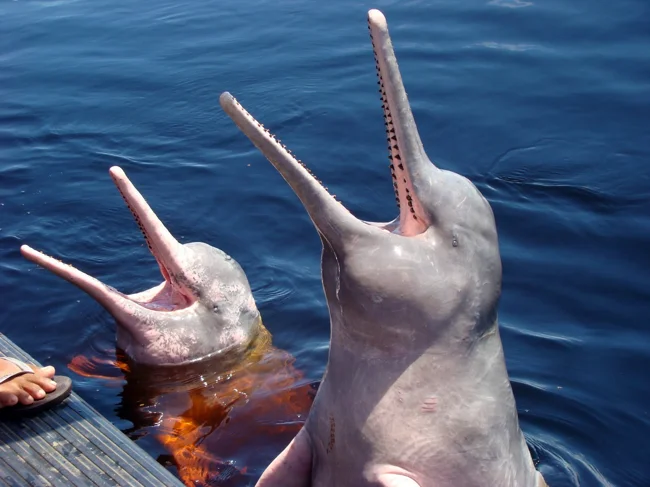
Ah, honey? Where are you pointing there? We can't see anything!
So Botu became the apex predator of the Amazon. Of all the dolphins, the river dolphin has the most varied diet: it includes more than 50 species of fish, amphibians and reptiles! In a day, the inia eats about 5% of its own weight. That's from 7.5 to 10 kg! 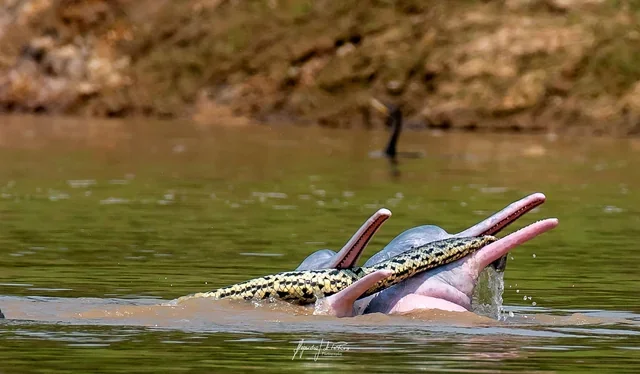
What other dolphin can boast that it ate anaconda for breakfast?
Not only physiological tricks help it catch prey, but also its wits. For example, the dolphin uses... people for hunting! More precisely, their boats. The frightened fish, running away from the ship without looking back, immediately falls into the mouth of the nimble boat. 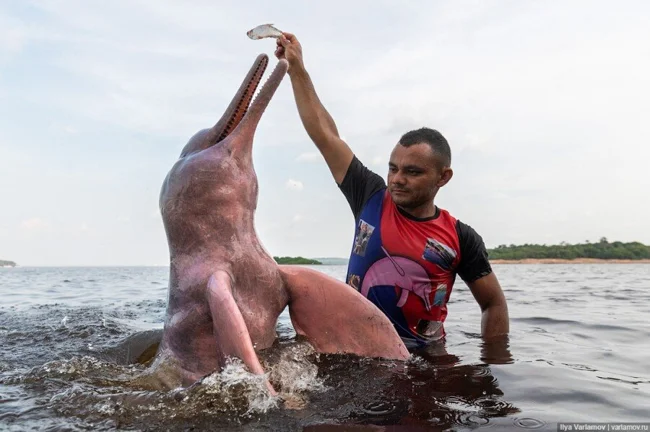
Among other dolphins, the Amazon dolphins are among the friendliest. They show interest in people, are easy to train, and are happy to make contact.
The inia also respects teamwork. In order to fill its belly to the brim, it teams up with both its own kind and other species, such as giant otters. The muggle company drives the frightened school into a circle, from which each hunter scoops out as much fish as he can swallow! 
A long nose helps dolphins catch even the most agile fish.
And the life of a bot would be a fairy tale, if not for their obsession with procreation! During the breeding season, charming plump dolphins become unrecognizable. From kind, playful and smart creatures, they turn into monsters. And their color is a clear proof of this. Inii are generally born dark gray. Dolphins acquire their signature crimson hue only at sexual maturity. Moreover, males are much more beautiful than females. Can you guess why? Pink skin is not just a color. These are traces of hundreds of battles, these are scars! 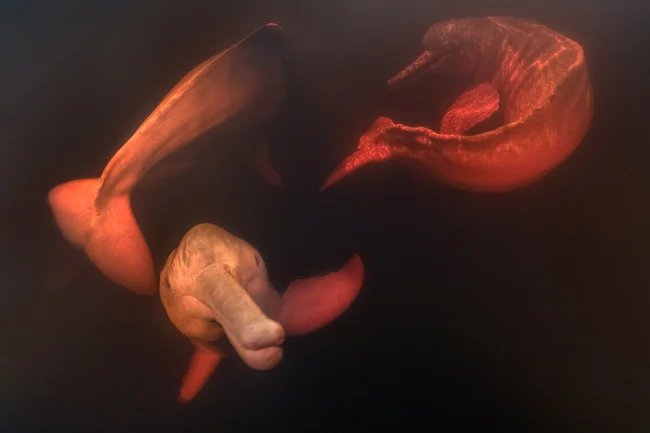
Do you know where I got these scars from?..
Growing male bachelors gather in groups of 3 to 15 individuals. The boys organize their own fight club. The first rule of such a club is to hit! Dolphins constantly push, shove, butt, bite. After such games, white scars remain on the thin gray skin. When the animal actively moves, gets excited or tenses, blood rushes to the small vessels under the skin. Because of this, the vessels begin to shine through the scars - this is how the dolphin acquires a pink color. 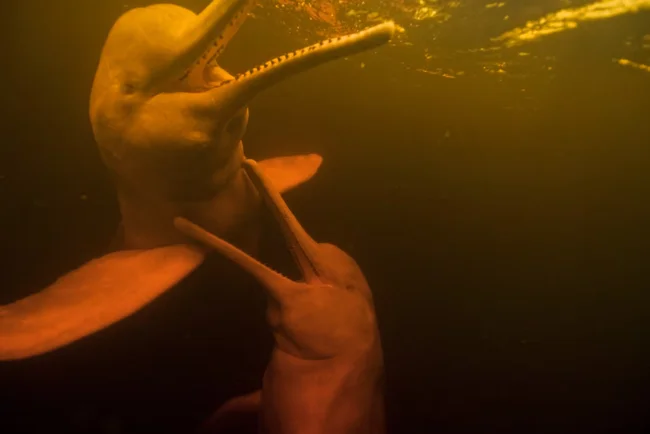
Yeah, give me more scars, then Svetka will go crazy about me!
In the fight club, the inii will spend up to 5-7 years. Everything that happens there is a game. But each mock fight hones skills before the real fight for the female. In May-June, the botu gather in flocks of up to 40 individuals. That's when the mayhem begins! Strong fighters who have trained for many years do not spare each other. The right to become a father is at stake - the chance cannot be missed. Each female is worth its weight in gold. Once pregnant, she will not be able to reproduce for the next three years! 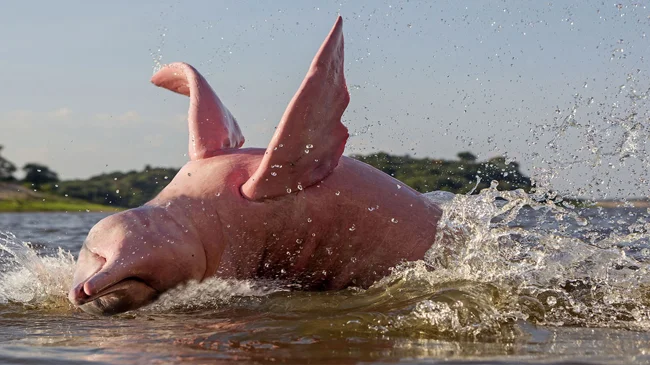
Throwed himself over the bend. Powerful!
That's why the brindled gentlemen are very persistent. First, gifts come into play: twigs instead of flowers, fresh fish instead of a sushi set. Then - foreplay with gentle nibbles on the fin. And then three hours of pleasure with each other! In captivity, one pair mated 47 times in less than 3.5 hours! 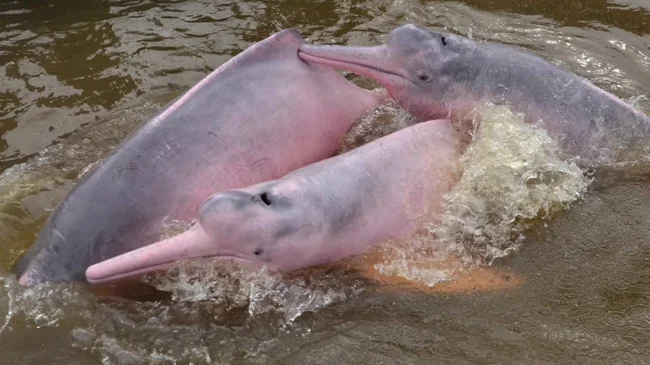
No, these are not sausages in a saucepan. These are the mating games of Amazonian dolphins!
When the passions subside, the veil of madness falls. The dolphins behave friendly, as if nothing had happened! The flocks break up. Pregnant females will carry the baby under their hearts for 11 months, after which they will go to river tributaries, temporary reservoirs and flooded forests. There is a lot of prey there, quiet and calm. In peace and quiet, they will spend the next 2 years with the baby. 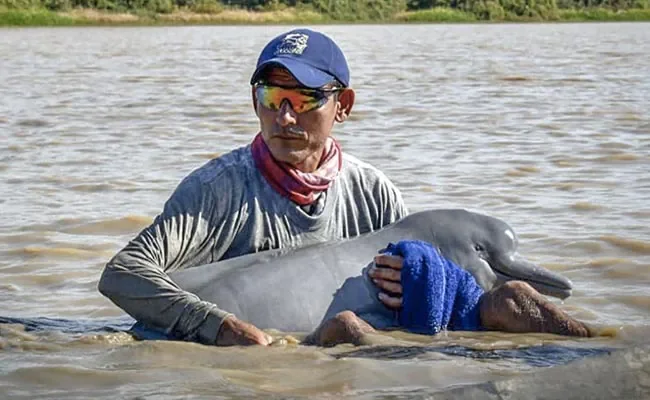
Mothers and cubs often get trapped. During droughts, temporary reservoirs disappear, and dolphins are left stranded. In such cases, people help them.
Males remain in the big water, but they no longer want to kill each other. Instead, they play, communicate, hunt and pee on each other! They can talk to each other using sounds, gestures and poses, as well as chemical signals. 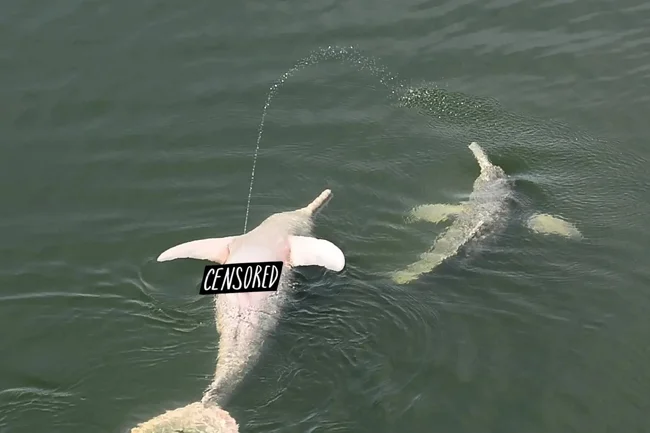
Some strange rain today. With Dima's taste.
Since everything dissolves quickly in water, they can't leave a mark like a cat on a sofa. So they have to be perverted. The males turn over on their bellies and urinate in the air, while another dolphin puts his muzzle under the stream. It doesn't sound very pleasant, but for the dolphins themselves, such a golden rain is something like a handshake.























